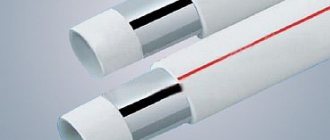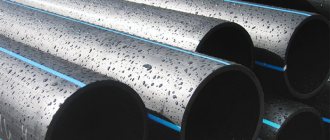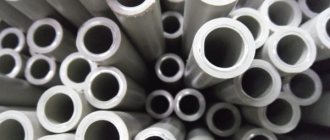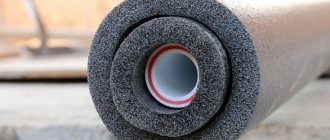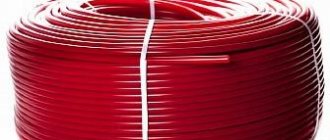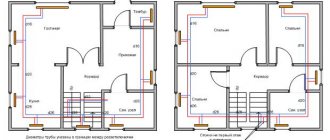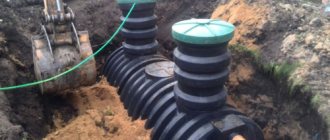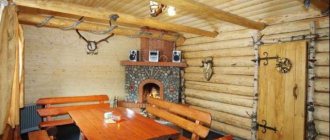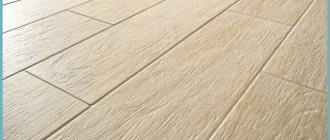Heating and plumbing made of polypropylene (PP-R) outperforms other plastic systems in an important criterion - the price of materials and components. The second cost item - installation of networks - many homeowners reduce to zero in a simple way - they carry out the work themselves. To weld joints, you purchase 2 devices - a soldering iron for polypropylene pipes with a set of nozzles and special scissors. It remains to be seen which welding machine is best to choose for home use.
Design of welding machine for PPR
A hand-held electric soldering iron (craftsmen call it an “iron”), designed for soldering plastic pipes and fittings, consists of the following parts:
- housing with a transformer block, thermostat and controls, equipped with a handle;
- a heating element with a power of 500 to 2 kW is installed in front of the case, depending on the model;
- stand and power cable connected to a regular 220 volt outlet.
Using the regulator, you can set the heating temperature of the mandrel within 0...300 degrees
Reference. In the operating instructions, manufacturers indicate that the device is suitable for joining various plastic pipes. In practice, electric soldering irons are used when installing PPR systems; polyethylene, metal-plastic and PVC pipelines are connected in other ways.
Heating of polypropylene parts is carried out using nozzles with a diameter of 16...63 mm (household series), coated with a Teflon non-stick layer. The appearance and principle of operation of the device has a certain similarity with a conventional iron:
- The user turns on the heating and sets the required temperature with the regulator, for polypropylene – 260 °C.
- When the platform with nozzles reaches a preset temperature threshold, the thermostat turns off the heating element.
- During the process of soldering the pipes, the surface of the “iron” begins to cool, so the automation activates the heating again.
Teflon-coated nozzles consist of 2 parts - a pipe is inserted into one, a fitting is inserted into the second.
For welding parts made of PP-R, a deviation from the established limit of no more than 5 degrees is allowed, polypropylene is heated to the melting threshold. Exceeding the temperature leads to a change in the structure of the material - the plastic “flows” and fills the flow section of the pipe.
Insufficient heating results in a poor-quality connection that loses its tightness after 3-12 months. How to properly weld a polypropylene joint, read in a separate material.
Soldering machines
For ease of use, the device is enclosed in a plastic case with a handle.
It is possible to install the soldering iron itself on a special tripod, which is usually included with the kit. The result is a convenient soldering machine, which is recommended for making most connections. In this case, entire sections of the polypropylene pipeline are assembled separately, and then mounted at the installation site and connected.
Using a soldering iron in the form of a machine allows one person to carry out the work, while when working by weight it is difficult to do without an assistant.
Obviously, heating a massive, large-diameter nozzle will require more heat than heating a small one. And the heating temperature must be maintained as accurately as possible, because underheating or overheating of the elements being connected leads to a significant decrease in the quality of the joint.
In the case when the temperature is lower than necessary for melting the polypropylene part, the ends may simply not “melt” with each other, and the joint will be leaky, and at a high temperature of the soldering iron, the material may leak, and the joint will look ugly.
A professional tool for soldering plastic pipes also includes a heating temperature regulator.
Types of "irons"
Hand soldering irons for plastic pipes are divided into types according to the following criteria:
- The shape of the heating element can be rod or xiphoid. The nozzles are attached to a cylindrical platform Ø32 mm with special clamps, and on a flat platform they are twisted through holes.
- Thermostat design is mechanical or electronic. The latter more accurately maintains the temperature for soldering.
- The number of attachments attached to the electric heater at the same time is from 1 to 4 pcs.
- Purpose. Professional and amateur models differ in body color; the specific color is chosen by the manufacturer himself.
Block attachments are placed on the core mandrel, secured according to the principle of a clamp
Note. Welding machines for professionals, for example, Dytron Polys P-4, are often equipped with a microprocessor controller that maintains the temperature within 260 ± 1.5 ° C. The second convenient option is a sound signal, notifying about the end of heating, the moment of rearrangement and the cooling time of the joint.
As a rule, amateur series of soldering irons are equipped with a mechanical thermostat and manual adjustment. Electronics and sound notification are a sign of a professional-class device (in addition to color and cost).
Let us characterize the various forms of heating elements:
- straight rod and sword-shaped platform is used for soldering PPR pipes with a diameter of 16...63 mm and simultaneously accommodates 2-4 nozzles;
- for socket welding of lines over 63 mm, an “iron” with a spherical element is used, to which 1 pair of nozzles is attached;
- An angular cylindrical platform is needed for working in hard-to-reach places, the maximum number of attachments is 2.
Czech machine Dytron Polys P-1b with an angular heating rod for block nozzles
Welding machines are rarely sold “naked”. Typically, the kit includes 3 “running” nozzles - for pipes of 20, 25 and 32 mm. The extended set includes all standard sizes in the range of 16…63 mm. The quality and reliability of the nozzles depends on the thickness of the Teflon layer. The coating of cheap elements wears off quickly, and polypropylene begins to stick during the heating process.
Reference. A complete set of soldering equipment also includes pipe cutters, fixing clamps, wrenches for attaching nozzles, a building level and even gloves.
Existing soldering iron designs
In appearance, the equipment for socket welding of plastic pipes is of the same type and differs only in the shape of the heater.
It can be of two types:
- flat;
- cylindrical.
A flat heater (installers also call it an iron for polypropylene pipes) has the appearance of a thick conical metal plate. The greater the mass of the heater, the better its ability to maintain a stable temperature when melting plastic. We talked in more detail about using an iron for welding polypropylene in this article.
Nozzles for melting the parts to be joined are fixed to the heater using bolts threaded through holes in the plate.
Soldering irons with a flat heater are bulky and can tip over, so it is necessary to place heat-resistant material on the floor in the workspace in advance
Soldering irons with a cylindrical heater are more compact and easy to use in hard-to-reach places. The attachments are fixed to them using a detachable clamp secured with clamping screws.
Soldering irons with a cylindrical heater are compact, but working with them alone is inconvenient. They need a stable stand
Due to the simplicity of the heater design and the absence of expensive elements in it, the cost of soldering irons ranges from 100-200 dollars, depending on their manufacturer, power and configuration.
Which soldering iron is better - rod or sword-shaped?
Judging by the reviews of master installers, the shape of the heater does not affect the quality of the connection of small-diameter pipes. But other factors play a role:
- if we compare equipment of the same price category, a soldering iron for polypropylene with a flat platform will cost less;
- a sword-shaped element, where you can put 3 pairs of nozzles, is more convenient to use on a table than when assembling ready-made heating sections in a private house;
- the rod platform allows you to attach the nozzle to the end of the heater and work in cramped conditions, getting to hard-to-reach places;
- The block attachment on the clamp is easier to replace during the installation process.
Advice. Balancing an electrical appliance by weight plays an important role. Check how comfortable the device fits in your palm and take a more suitable model.
Soldering iron device
Polypropylene, despite its relatively recent appearance on the market, has already earned great trust among builders and owners. PVC pipes are reliable, durable and demonstrate good performance - and with all these advantages, they are also incredibly simple to install, requiring only a special soldering iron. To understand the structure of a soldering iron, it is worth considering its design in the photo, but you also need to know its main components.
The PVC pipe welding machine includes the following elements:
- Body with handle.
- Thermostatic element.
- A heating element in a dense metal casing, necessary for heating the device.
- A set of different-sized Teflon-coated nozzles.
The operating principle of the soldering iron is quite simple. In professional jargon, it is often called an “iron” due to the similarity of the work process. After connecting to the mains, the heating element of the soldering iron heats up, the heat is transferred through the outer plate to the installed nozzles, and they, in turn, ensure softening of the polypropylene.
Of course, the heating process is carefully controlled - exceeding the temperature is fraught with excessive melting of the pipe, and a low temperature is simply not enough for a normal connection of the material. The absence of a thermostat entails serious consequences - not only will the soldering iron simply not be able to work, it can also lead to its damage, up to the final melting of the elements and failure of the device.
If you have no experience working with a soldering iron for PVC pipes, it is better to opt for expensive and high-quality models - they are equipped with more reliable temperature regulators that protect the structure from damage. Most inexpensive devices cannot boast this level of security, so they will be much more difficult to use.
When talking about soldering iron attachments, you should first of all evaluate the thickness of the non-stick layer - it affects the durability of the elements and the quality of the connection. Choosing cheap nozzles (they are produced in large quantities in Turkey and China) always leads to negative consequences - burnt-out Teflon allows polypropylene to freely stick to the nozzles, thereby damaging both the material and the tool itself for soldering PVC pipes.
Popular brands and equipment prices
The range of “irons” for soldering PPR pipelines is very wide, so it is not easy to create a reasonable rating of products. We propose a different approach: we list the manufacturers of soldering irons that appear most often in reviews on various forums:
- The highest price category is Rothenberger (Germany), Dytron (Czech Republic), Rekon (Britain, produced in China). Prices range from 235...400 USD. e.
- Electric soldering irons of average cost - CANDAN (Turkey), Valtec (Italy - China), PATRIOT (USA - China), SUPER-EGO (Spain). Prices – from 55 USD. e.
- Other devices under $50, produced in the countries of the former USSR and China. There are a lot of manufacturers: Forte, Brima, Caliber, Enkor, Resanta and so on.
The prices of welding heaters greatly depend on the configuration. A set of high-quality nozzles with standard sizes up to 63 mm inclusive costs more than any Chinese soldering iron. Compare cheap devices with more expensive ones, see the video:
The second factor is the reliability of the device design. For example, an amateur version of the Czech brand Dytron Polys P-1b will cost 155 USD. That is, professional Dytron Polys P-4a already costs 215 USD. e.
Types of welding of polypropylene pipes
You can connect elements of plastic wiring from polypropylene pipes using threaded fittings or three welding methods:
- electrofusion;
- butt;
- bell-shaped
There is a fundamental difference between soldering polypropylene pipes up to 63 mm and larger than this size.
Pipes with a small diameter (up to 63 mm) are connected using the socket method, that is, by inserting the cut edge of one pipe into the expanded edge (socket) of the fitting. The socket connection method provides a high degree of tightness due to the large contact area of the two soldered products and the absolute coincidence of their diameters.
Recommendations for choosing a soldering iron
Craftsmen who have been working with polypropylene for a long time do not need our advice - they have learned from their own experience which tool is better to choose. Another thing is for beginners and ordinary homeowners who want to save money on installation once and solder the heating with their own hands. You should select a soldering iron according to the following criteria:
- power;
- price;
- heater geometry and number of installed nozzles;
- convenience of a tripod (stand).
Advice one. To practice welding and soldering a home heating system made of polypropylene, it is enough to buy an inexpensive Chinese machine. It will easily withstand installation work and will serve subsequently, in case of repair or alteration. We will reveal some of the nuances of using a cheap tool further.
The minimum tool kit (on the left) includes only a soldering iron, 3 attachments and a wrench with a screwdriver.
Let's move on to the rest of the recommendations:
- The iron needs sufficient power to quickly react and heat the platform upon contact with the pipe and fitting. For a device with one nozzle, 600 W is enough for welding pipelines with a diameter of up to 40 mm.
- For 3 nozzles and pipes Ø16...32 mm, choose a soldering iron with a power of up to 1.2 kW, no more is needed.
- If your budget allows, buy a Turkish-made welding device, for example, CANDAN. The soldering iron is reliable and of relatively high quality, tested by craftsmen.
- To work in uncomfortable conditions, it is better to take the rod version of the device.
- Don’t skimp on nozzles - buy 2-3 of the required sizes, but of good quality.
- Make sure that the soldering iron does not dangle in the tripod, this reduces the convenience of working.
Now about saving by renting equipment. For a beginner, renting an iron is not profitable - it’s easier to buy a cheap device of the lowest price category. But sometimes large polypropylene sellers hold promotions - when you buy a certain number of pipes, they give you a soldering iron for temporary use for free.
If you decide to choose an inexpensive soldering iron model, you need to take into account one nuance: such a tool often fails with the heating temperature, the error reaches ±10 degrees. The way out of the situation is simple: using a contact thermometer or pyrometer, you adjust the real temperature experimentally, taking measurements and adjusting the device with a manual regulator.
Comment. Do the same when working with polypropylene of unknown origin. Such material often melts prematurely or, conversely, requires more intense heating.
The problem with a dangling tripod is also completely solvable. The stand is screwed to the table with a clamp, and the soldering iron is fixed in the socket with a self-tapping screw, as was done above in the photo. And lastly: the power cord of cheap models quickly gets twisted near the case, and the copper wires break. It is necessary to monitor the wire or tighten it with electrical tape.
CANDAN SM-05
Best price-performance ratio Country: Turkey Average price: 6,000 rub. Rating (2019): 4.9
The Turkish-made CANDAN SM-05 soldering iron has the best price-performance ratio. In its model range, this is the most powerful machine for welding polypropylene pipes. Thanks to the dual-circuit control system, you can simultaneously or alternately turn on both heaters with a power of 1.2 kW each. The device is intended for installation of pipelines from pipes with a diameter of 90-160 mm. Information about heating is given to the master by two light indicators. They go out when the nozzles warm up to operating temperature. The thermostat maintains temperature conditions in the range of 50-320 degrees. The heater is made of stainless steel; the device has one hole for a welding attachment.
Consumers are satisfied with the ratio of price, performance and durability. The craftsmen are pleased with the quality of workmanship and selection of materials. Some users would like to see a wider range of attachments.
Attention!
The information presented above is not a purchasing guide. For any advice you should contact specialists!
Choosing a soldering iron for polypropylene pipes
At first glance, a soldering iron is a very simple device, but choosing a good tool is not easy. Among the large number of market offers, it is necessary to choose the optimal model for independent work.
You can get qualified help from a consultant, but this is unlikely to help. The consultants’ task is to sell the goods on the shelves of their store, but they may not know anything about the advantages and disadvantages of other manufacturers.
Based on this, first of all you should familiarize yourself with the characteristics and parameters of various instrument models. By comparing and analyzing the data, it is already possible to draw some conclusions. First, you can find out the country where the product was produced.
Producing countries
The final result of the quality of the work performed largely depends on the equipment, and a quality tool is directly related to the country of origin. Equipment for welding polypropylene pipes must be reliable in operation, have stable power and produce the required temperature.
Based on real consumer reviews, a rating list of manufacturers by country has been created, although it is unspoken, it is true:
- Czech Republic - the equipment has professional functionality, high quality attachments and operational reliability.
- Türkiye is an excellent alternative to expensive Czech soldering irons. It is worth noting that, in addition to good quality products, low-quality products also appeared. Several manufacturers offer their products with an excellent quality-price combination - these are Valtec, Kalde and Candan.
- Russia - recently, several domestically produced enterprises have offered the market soldering irons with the ability to perform high-class work. A distinctive feature of this equipment is its low cost.
- China - it is worth noting that low cost is not always justified. Most soldering irons are of poor quality and do not receive high ratings from professionals.
Feedback from craftsmen regarding the country of origin is divided. Everyone unanimously praises Chekhov, but many refuse due to the high cost. Regarding Turkish products, it is recommended to carefully check the package contents. Some home craftsmen make a soldering iron on their own for one-time use using an MLT resistor, but they do not fully replace standard equipment.
Before going to the store, if you do not have the appropriate experience, we strongly recommend that you get a recommendation from a professional, for example, visit the appropriate forum or ask a familiar master. Often, banal Chinese counterfeits are sold under the brand name of a well-known manufacturer.
Famous manufacturers
Candan - Welding equipment from a Turkish manufacturer is distinguished by good quality, technical characteristics and an affordable price.
Valtek - Joint Russian-Italian production enjoys a good reputation, producing reliable high-quality devices.
REMS - Good, high-quality German equipment. The company has been in the power tools market for over a hundred years. It stands out for its long-lasting heating element and precise mechanical temperature controller.
Gerat Weld - A rare example of good quality Chinese manufacture for household work. Acceptable combination of price and quality and average power of 1.5 kW. If necessary, you can work with two nozzles at the same time.
Рrorab — Lightweight and convenient device at low cost. The Chinese manufacturer equips the soldering iron with special gloves, an allen key, a screwdriver and a tape measure.
Sturm - A more expensive tool designed for professional work. The equipment is capable of welding not only round pipes, but also sword-shaped pipes.
Aquaprom - Soldering irons of a domestic manufacturer, they have a low cost and extensive equipment. Thanks to it, you can easily cope with laying a pipeline in an apartment or greenhouse. Does not apply to professional equipment.
Bosch - The most suitable tool option for a beginner. The German manufacturer creates reliable and durable tools. The package includes a large number of nozzles of various diameters.
Rotorica - The Russian company produces excellent equipment suitable for professional work and home use. Adapted for use in various conditions. They have a digital thermostat and Teflon-coated nozzles.
Elektromash - Offers soldering irons designed for welding polypropylene pipes. The tool is from a domestic manufacturer of fairly high quality and relatively low cost.
Leroy Merlin is not a manufacturer of such equipment, but it proudly ranks first among distributors. Leroy Merlin has been working in our market for a long time and enjoys a good reputation. On the shelves of this store you can find a large selection of equipment for welding polypropylene pipes from different manufacturers and for various uses. In addition, you can get quite qualified advice.
Tool power
When choosing a device, power has a functional meaning. To connect a 50 mm pipe or smaller diameter, a soldering iron with a power of 1 kW is sufficient. A larger diameter pipe has a thicker wall and it needs to be heated better, so a more powerful tool up to 2 kW is used.
Recently, ultra-efficient soldering irons have appeared on the market, which consume less than 1 kW of energy and are capable of soldering pipes of maximum diameter.
Professionals prefer to purchase a universal tool with a power reserve that can cope with long-term uninterrupted loads. A hobbyist buys inexpensive equipment that can solder several sizes and is used periodically.
Choosing the right nozzle
- A low-capacity soldering iron is capable of high-quality work with a small diameter. A low-power tool is not able to warm up a large nozzle. When purchasing, you should make sure that the capabilities of the tool correspond to the configuration.
- When choosing a device, personal needs are taken into account: When working, a professional craftsman is faced with pipes with a diameter of 10 to 110 mm, and in his work he can even use several different soldering irons.
- There is no need for a home craftsman to purchase large nozzles; at home you can find pipes of only three diameters - 16, 24, 32 mm.
On the farm , it is better to have several different nozzles of the same diameter, and the greater the range of sizes, the more confident the master feels.
